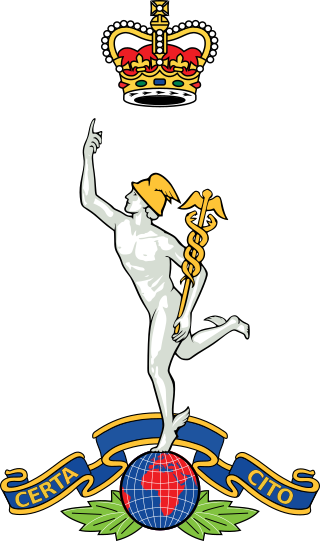Options for Change was a restructuring of the British Armed Forces in summer 1990 after the end of the Cold War.

The 11th Security Force Assistance Brigade is a brigade of the British Army which is intended to train and assist foreign forces. In 2021, under the Future Army changes, the brigade was redesignated, formerly being the 11th Infantry Brigade & HQ South East. Prior to the Army 2020 changes in 2013, the brigade was temporarily activated for deployment to Afghanistan. Originally formed in the Second Boer War, the brigade was engaged during both World Wars.

The 2nd Signal Brigade, was a military formation of the British Army composed of Royal Corps of Signals units. The brigade was first formed following the reorganisation of the old Territorial Army in 1967, and was disbanded in 2012 under the Army 2020 programme. However, later the 2nd Signal Group was formed continuing the lineage of the old brigade, before it was disbanded in 2018.

The Berlin Infantry Brigade was a British Army brigade-sized garrison based in West Berlin during the Cold War. After the end of World War II, under the conditions of the Yalta and Potsdam agreements, the Allied forces occupied West Berlin. This occupation lasted throughout the Cold War. The French Army also had units in Berlin, called the French Forces in Berlin and the US Army's unit in Berlin was the Berlin Brigade.

The 1st Signal Brigade, formerly known as the 1st Signal Group, is a brigade of the British Army. The group was first formed in 1968 as a result of the 1966 Defence White Paper which expanded support for NATO and the British Army of the Rhine. In 1987, the group was disbanded and merged into the 2nd Signal Brigade. In 1995, the brigade was reformed and has since deployed on operations across the globe in support of NATO and HQ Allied Rapid Reaction Corps.

8th Engineer Brigade is an engineering support formation of the British Army, which forms part of 1st Division.

The Cinque Ports Fortress Royal Engineers was a volunteer unit of Britain's Royal Engineers serving in the defences of Dover, one of the historic Cinque Ports. It provided detachments for field service in World War I and in World War II, when they saw active service in Tunisia, Italy and Greece. Its lineal descendant continues to serve in the present day Army Reserve as a bomb disposal unit.
The Renfrewshire Fortress Royal Engineers was a Scottish volunteer unit of the British Army under various titles from 1888. Its main role was defence of the ports and shipyards on the River Clyde, but it also provided detachments for active service in the field during both World Wars. Its successors continue to serve in the Army Reserve.
The North Riding (Fortress) Royal Engineers was a volunteer unit of Britain's Royal Engineers formed for the defence of the Tees Estuary in the North Riding of Yorkshire. As well as serving in this role it also provided specialist engineer units in both World Wars. Its descendants continued to serve in the Territorial Army until 1999.
The following is a hierarchical outline for the structure of the British Army in 1989. The most authoritative source for this type of information available is Ministry of Defence, Master Order of Battle, and United Kingdom Land Forces, HQ UKLF, UKLF ORBAT Review Action Plan, HQ UKLF, 1990.

The 29 Group, formerly 29 Engineer Brigade, is an engineer formation of the British Army responsible for Explosive Ordnance Disposal and Search. Its headquarters were at Aldershot, now at Didcot.

The 7th Signal Regiment was a regiment of the Royal Corps of Signals within the British Army. The unit and its predecessors supported 1st (British) Corps from 1911 until the end of the Cold War. Afterwards the regiment supported the Allied Rapid Reaction Corps until its disbandment in 2012.

21 Signal Regiment is a signal regiment of the Royal Corps of Signals within the British Army. The regiment was, until the initial Army 2020 reforms, the only signal regiment to support the Royal Air Force.

170 Engineer Group was an engineering group of the British Army's Corps of Royal Engineers.
13 Signal Regiment is a signal regiment of the Royal Corps of Signals within the British Army.

The 1st Field Engineer Squadron is an engineer unit of the Corps of Royal Engineers within the British Army. The squadron was first formed in 1914 following the mobilisation of the Army for the First World War. The squadron later supported The Cavalry Division and the first British Army of the Rhine. The squadron later saw service in the Second World War and today supports the 21st Engineer Regiment of the new 1st Strike Brigade.

The GurkhaAllied Rapid Reaction Corps Support Battalion, or simply the GurkhaARRC Support Battalion is a combat support unit of the British Army, and one of only three units permanently assigned to NATO. For administrative purposes, the Gurkha ARRC Support Battalion falls under the oversight of the Royal Logistic Corps, though employs members from many other cap badges.

Kimberley Barracks is a military installation on Deepdale Road in Preston in Lancashire, England PR1 6PR.
The 2nd Division Transport Regiment was a military support unit of the British Army, forming part of the Royal Corps of Transport. Initially formed in 1953, the regiment would serve the 2nd Infantry Division until its first disbandment in 1984 following a reorganisation of the British Army of the Rhine. Reformed one year later, it would finally be disbanded in 1993 following the End of the Cold War.

299 Parachute Squadron, Royal Engineers is a specialist field engineer squadron of the British Army's Corps of Royal Engineers and the only reserve parachute unit of the corps. Formed in 1947 as an airborne field squadron, 299 Para Sqn would see many reorganisations and new roles, until 2006 when it took on the parachute role it maintains today. As of 2021, it is the only reserve parachute-trained squadron of the Royal Engineers.













